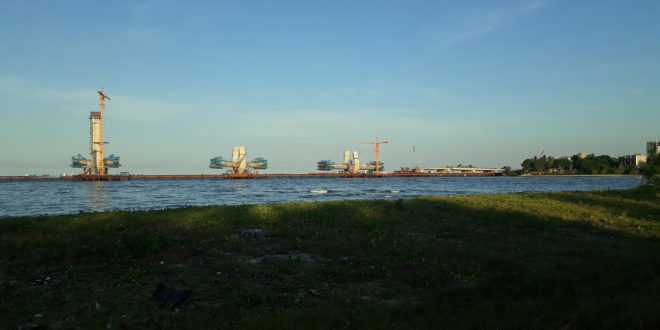Come danzare in punta di diapason sull’Oceano Indiano
in ARCHITETTURA | architecture

© arcomai I Vista del Ponte Selander in via di completamento.
L’UNESCO ha affermato che Dar es Salaam, la più grande e trafficata città della Tanzania, e” la seconda metropoli africana col più alto livello di crescita dopo Lagos (Nigeria). Da quando (una decina di anni fa) e’ stato avviato un processo di riforma delle politiche del traffico regionale, l’ex capitale del paese ha, senza dubbio, cambiato il suo aspetto urbano; e questo grazie anche al DART (Dar Rapid Transit), la società di trasporto che dal 2016 ha dato un grande slancio all’ammodernamento del sevizio pubblico su gomma. Di questa trasformazione il nuovo Ponte Selander, che costeggia il litorale affacciato sull’Oceano Indiano, può rappresentare a pieno titolo questo memorabile decennio di Dar.
L’opera, nata da un’intesa tra la Tanzania e la Corea del Sud, sarà lunga 6,2 km – di cui 1,2km di ponte – ha un costo di 126,26 milioni di dollari, coperti per l’82,9% dal paese asiatico mentre il restante finanziato dalla Tanzania. Questo progetto rientra nel piano del Fondo per la Cooperazione allo Sviluppo Economico della Corea (EDCF), che ha messo a disposizione un pacchetto di prestiti per un totale di 91 milioni di dollari finalizzato alla crescita economica delle nazioni in via di sviluppo. È il più grande prestito mai concesso per un progetto di capitale sociale in Africa. La realizzazione e’ ad opera della società coreana GS E&C (GS Engineering Corporation) e dalla locale Tanzania National Roads Agency. L’infrastruttura dovrebbe essere completata entro giugno del 2022.
In questi ultimi cinque anni la GS E&C ha compiuto sforzi rilevanti per espandere la sua presenza in Africa. Tra gli obbiettivi raggiunti registriamo: l’installazione di una linea di trasmissione di potenza da 132 kilovolt che collega il Kilimangiaro e Arusha nel nord della Tanzania, la costruzione della centrale elettrica/gas a ciclo combinato di Kais in Algeria, una raffineria di petrolio in Egitto ed una linea di trasmissione di potenza da 330 kilovolt a Kumasi, in Ghana.

© arcomai I Vista del Ponte Selander in via di completamento.
L’infrastruttura, che mira a facilitare il traffico tra Msasani e il Central Business District (per intenderci tra l’area di Coco Beach e l’Ospedale Aga Khan), contribuirà a snellire gli ingorghi sull’arteria strategica di Ali Hassan Mwinyi Road. Forte di una capacità di 180 tonnellate sarà in grado di “traghettare” ben 55.000 veicoli al giorno, con significativa riduzione della congestione e dei tempi di percorrenza lungo tale asse. A struttura prende il nome dal vecchio ponte Selander che fu costruito nel 1929 da John Einar Selander, il primo direttore dei lavori pubblici del Tanganica, la denominazione della Tanzania prima dell’unificazione con Zanzibar nel 1964. Il cantiere è attualmente completo per circa l’80%.
Il ponte ha una lunghezza di 670 metri ed una larghezza di 20,5 metri. Allo stato, la costruzione dei 254 pilastri di fondazione è stata completata in tandem con la realizzazione della piattaforma necessaria per la posa di una fondazione permanente del ponte. I cinque piloni in cemento armato a forma di forcelle giganti – che ricordano la silhouette di un diapason – sono oramai completati. La prossima fase sarà quella “spettacolare” di montare i tiranti per le cinque campate del ponte di cui le due centrali, sorrette da un puntone monumentale, avranno una luce di ben 125 metri. Per la sua realizzazione sono stati impiegati circa 600 persone, di cui il 92% tanzaniane. Inoltre, solo l’8% de personale tecnico proviene dall’estero. Se a ciò si aggiungono poi i 24 ingegneri del Ministero dei Trasporti e delle Comunicazioni che stanno ricevendo una formazione nell’ambito del progetto, possiamo dire che si tratta di un viadotto quasi totalmente Made in Tanzania. La carreggiata del ponte non sarà molto alta rispetto al livello del mare. Apparirà come la materializzazione dell’orizzonte dell’Oceano Indiano dando l’impressione che la struttura danzi sulle acque del mare. Non a caso in ingegneria le opere vanne sempre eseguite “a regola d’arte”.
.
© arcomai I Vista del Ponte Selander in via di completamento.
